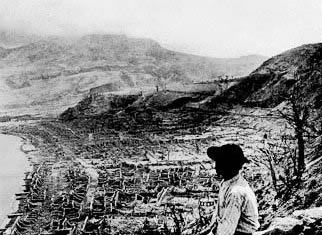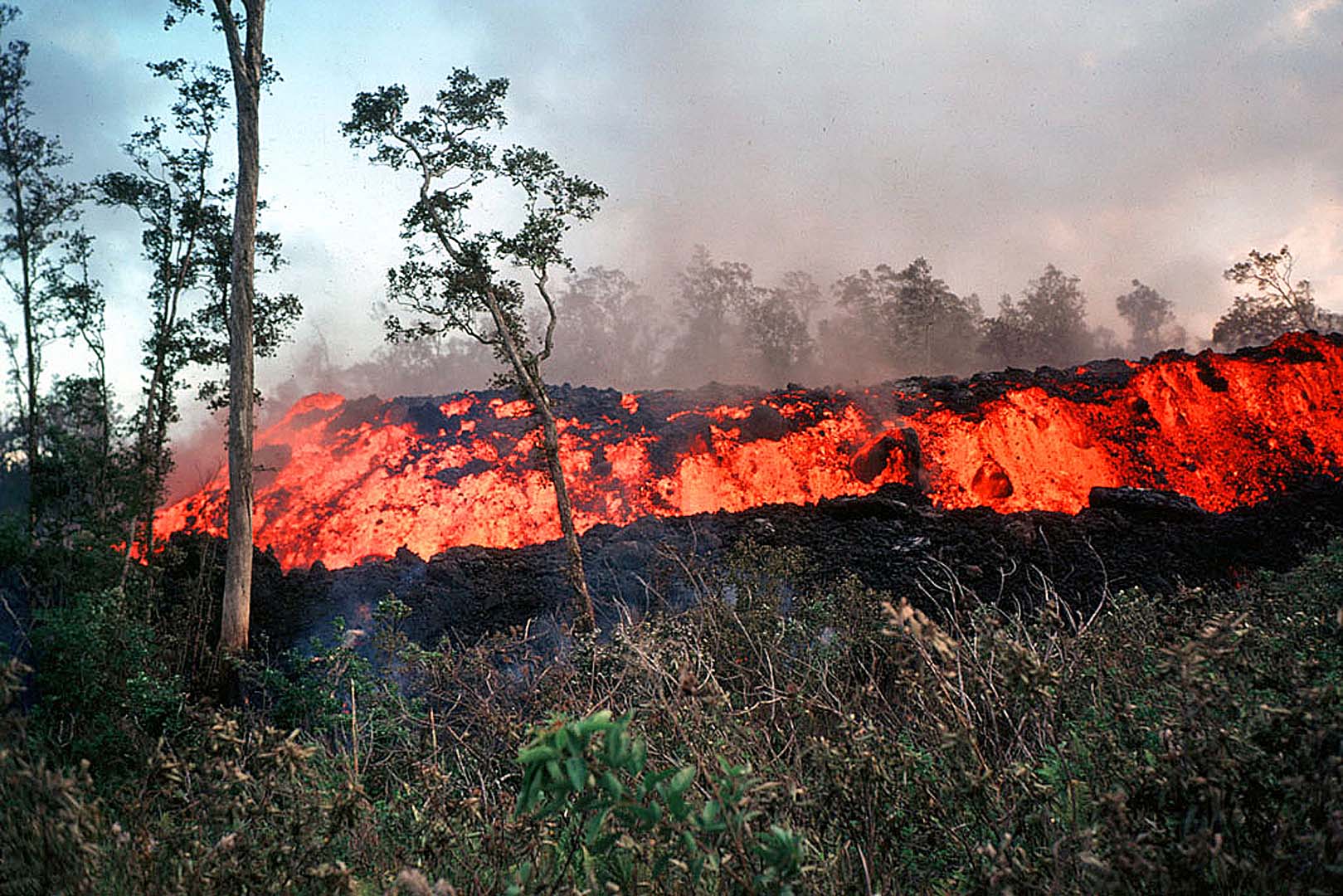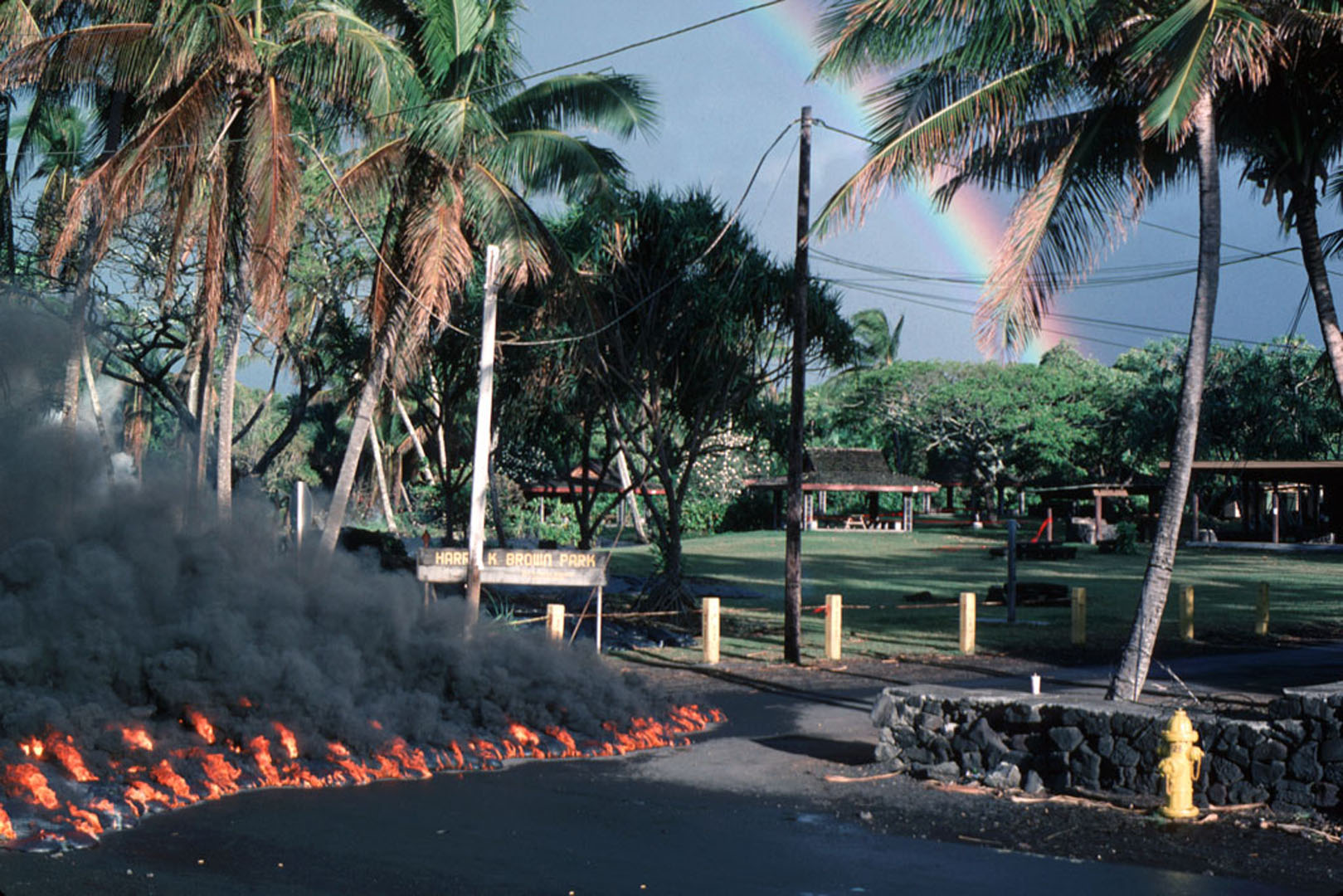Volcanic eruptions can have a profound impact on humans and the surrounding landscape. They can lead to loss of human life and wildlife, and to extensive damage of property and infrastructure. Some of the prominent hazards of volcanic eruptions include pyroclastic flows, lahars, lava flows, ash, gas emissions, landslides, and tsunamis.
Pyroclastic flow: A pyroclastic flow is a mixture of hot gas and ash. Pyroclastic flows can travel at speeds up to 300 km/h (186 mph), and can reach temperatures up to 800° C (1,470° F). They are generally considered the greatest threat to human life during an eruption. Pyroclastic flows can travel down the side of a volcano so quickly and with such force, that they can knock down trees and incinerate buildings. Anything living in the path of a pyroclastic flow will suffer almost certain death.
The power of pyroclastic flows was forcefully demonstrated during the 1902 eruption of Mt. Pelée on the Caribbean island of Martinique. Approximately 29,000 people died on May 8 as a huge pyroclastic flow enveloped the town of St. Pierre, just below Mt. Pelée.
Lahars: A lahar is an Indonesian word that describes a mudflow that forms on the sides of volcanoes when volcanic debris (i.e., rocks, ash, etc.) mixes with water. Lahars have the consistency of wet cement, and can travel at speeds up to 50 km/h (31 mph). They typically follow existing drainage patterns and are considered to be the second most dangerous volcanic hazard after pyroclastic flows. The majority of deaths as a result of the eruption of Mt. St. Helens in 1980 were due to lahars.
Lava flows: Lava flows are among the most spectacular of volcanic hazards, yet they are among the least dangerous. Loss of life due to lava flows is quite rare because of the slow speed of the lava, typically not exceeding a few kilometers (roughly 2 miles) per hour. Lava flows, however, generally destroy any structure that is in their path.

No eruption from Vesuvius was more catastrophic than the two day eruption that occurred in 79 C.E. Go to History Link...
The Human Cost of the Pu’u’ Ō’ō Lava Flows
Pu’u’ Ō’ō, part of Kilauea volcano in Hawaii, has been erupting constantly since 1983. (See the Try This – Explore Kilauea Lava Flows in F2-1 for more information on the Kilauea flows.)
- Click here to zoom in on Pu’u’ Ō’ō.
Since 1983, mafic lava from Pu’u’ Ō’ō has covered over 123.2 km2 (47.6 mi2) of land. It is estimated that approximately 3.5 km3 (0.89 mi3) of lava has emerged from Pu’u’ Ō’ō since it began erupting.
- Click here to zoom in Highway 130 and Highway 137.
- What is unusual about Highway 130 and Highway 137?
Highways 130 and 137 are aiming to an intersection point, but that intersection point is covered by a lava flow.
In 1990 the village of Kalapana, located to the west of the intersection of highways 130 and 137, was almost completely destroyed by lava flow from Pu’u’ Ō’ō. This lava flow also destroyed parts of Highway 130 and Highway 137.
- Click here to see the location of the buried village of Kalapana.
The destruction of Kalapana in 1990 was not the first time that lava flows from Pu’u’ Ō’ō had interfered with human settlements. Parts of a large planned subdivision known as the Royal Gardens Subdivision have been repeatedly affected by lava flows over the years. The subdivision has now been largely abandoned.
- Click here to see the location of the Royal Gardens subdivision.
Parts of roads constructed for the Royal Gardens subdivision are still visible between old lava flows.
- Click here to see the remains of these roads.





